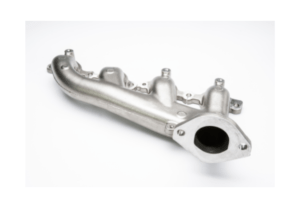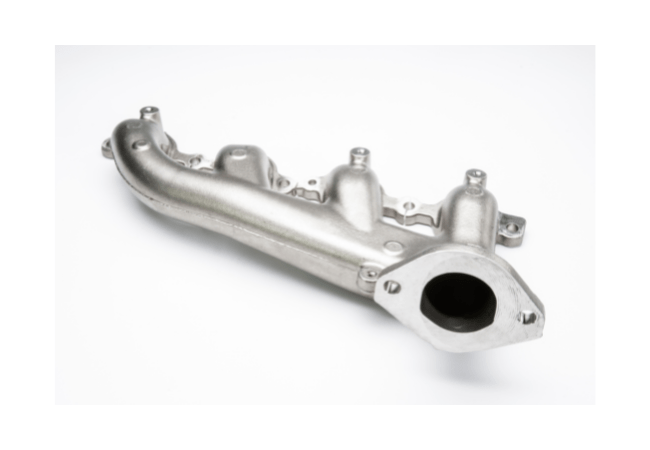An exhaust manifold is an essential component of the vehicle’s exhaust system, responsible for collecting the exhaust gases produced by the engine’s combustion process and routing them to the catalytic converter. It is typically mounted on the engine’s cylinder head, and its design and construction play a crucial role in the performance of the engine.
The importance of the exhaust manifold cannot be overstated, as it is critical to the proper functioning of the engine and the overall performance of the vehicle. The manifold helps to reduce backpressure in the exhaust system, allowing the engine to breathe more easily and enhancing its performance. It also plays a vital role in reducing harmful emissions and minimizing engine noise, making for a smoother and more efficient driving experience. Discover what is an exhaust manifold and what is its primary function within the exhaust system.
Exhaust manifolds are typically made of cast iron or stainless steel and are designed to withstand the high temperatures and corrosive exhaust gases produced by the engine. The design and construction of the manifold can vary depending on the make and model of the vehicle, as well as the intended use of the engine. For instance, tubular exhaust manifolds are typically used in high-performance engines as they offer better airflow and less restriction, while cast iron manifolds are commonly found in less powerful vehicles due to their durability and cost-effectiveness. Overall, the design and construction of an exhaust manifold are critical to its proper functioning and the overall performance of the engine.
Jump to
Types of Exhaust Manifolds

Exhaust manifolds come in different types, each with its own advantages and disadvantages. One of the most common types is the cast iron manifold, which is typically found in less powerful vehicles. Cast iron manifolds are durable and cost-effective, making them a popular choice for manufacturers. However, they can be heavy and restrictive, which can limit their performance potential.
Another type of exhaust manifold is the tubular exhaust manifold, which is typically found in high-performance vehicles. Tubular manifolds are made of individual tubes that are welded together, creating a more efficient and streamlined design. This type of manifold offers better airflow and less restriction than cast iron manifolds, which can result in improved performance. However, they can be more expensive to manufacture and are often less durable than cast iron manifolds.
Finally, header exhaust manifolds are a popular choice among performance enthusiasts. These manifolds feature individual tubes for each cylinder, which are then gathered together into a collector. The collector helps to increase exhaust velocity and create a scavenging effect, which can further enhance performance. Header manifolds are typically made of lightweight materials like stainless steel or titanium, which can improve their performance potential. However, they can also be more expensive and require more maintenance than other types of exhaust manifolds.
The type of exhaust manifold that is best for a vehicle will depend on a variety of factors, including the make and model of the vehicle, its intended use, and the desired performance characteristics. Cast iron manifolds are a good choice for those looking for a cost-effective and durable option, while tubular manifolds are ideal for those seeking improved performance. Header manifolds are typically the best choice for performance enthusiasts who are willing to invest in their vehicle’s performance potential. Whatever type of exhaust manifold is chosen, it is important to ensure that it is properly designed and installed to ensure optimal performance and efficiency.
Functions of the Exhaust Manifold
The exhaust manifold is a vital component of a vehicle’s exhaust system, responsible for performing several critical functions. One of its primary functions is to collect exhaust gases produced by the engine’s combustion process. The manifold is typically mounted on the engine’s cylinder head and features a series of pipes that are designed to collect the exhaust gases from each cylinder. This ensures that all of the engine’s exhaust gases are efficiently collected and routed through the exhaust system.
Another important function of the exhaust manifold is to route the collected exhaust gases to the catalytic converter. The catalytic converter is responsible for reducing harmful emissions, such as carbon monoxide, hydrocarbons, and nitrogen oxides. By efficiently routing the exhaust gases to the catalytic converter, the manifold plays a crucial role in reducing the vehicle’s environmental impact.
In addition to its environmental impact, the exhaust manifold also plays a significant role in improving the engine’s performance. The manifold helps to reduce backpressure in the exhaust system, allowing the engine to breathe more easily and enhancing its performance. It also plays a vital role in reducing engine noise, making for a smoother and more pleasant driving experience. Overall, the exhaust manifold’s functions are critical to the proper functioning of the engine and the overall performance of the vehicle.
Common Issues with Exhaust Manifolds
Exhaust manifolds are designed to last for the life of the vehicle, but they can develop issues over time due to various factors. One of the most common causes of exhaust manifold issues is cracking. The manifold is subject to high temperatures and thermal cycling, which can cause it to expand and contract repeatedly. This can create stress on the manifold, leading to cracks and leaks. In addition, age and wear can also contribute to the development of cracks in the manifold.
Another common issue with exhaust manifolds is warping. Warping can occur when the manifold is subjected to extreme temperatures and thermal stress, causing it to distort or become misshapen. This can lead to a loss of performance, as well as an increased risk of leaks and other issues.
Leaks are another common issue with exhaust manifolds. Leaks can occur due to a variety of factors, including cracks, warping, or poor installation. A leak in the manifold can cause a loss of performance, as well as increased emissions and noise. In addition, a leak can also create a safety hazard, as it can allow exhaust gases to enter the passenger compartment.
Exhaust manifold issues are relatively common, but they can be prevented or mitigated by proper maintenance and care. Regular inspections and maintenance can help to identify issues early and prevent more significant damage from occurring. If an issue is identified, it is important to address it promptly to prevent further damage to the vehicle and ensure optimal performance and efficiency.
Effects of Exhaust Manifold Issues
Exhaust manifold issues can have a significant impact on a vehicle’s performance and safety. One of the most noticeable effects of exhaust manifold issues is a decrease in engine performance. The manifold plays a critical role in removing exhaust gases from the engine, and any issue with the manifold can result in restricted airflow, leading to a loss of power and acceleration. This can impact the overall drivability of the vehicle and reduce fuel efficiency.
In addition to decreased performance, exhaust manifold issues can also lead to an increase in exhaust emissions. When the manifold is not functioning correctly, it can cause a build-up of exhaust gases in the engine, resulting in increased emissions of harmful pollutants such as carbon monoxide, nitrogen oxides, and hydrocarbons. This not only contributes to environmental pollution but also poses health risks to passengers and pedestrians.
Finally, exhaust manifold issues can also pose safety risks. If the manifold is cracked or leaking, it can allow exhaust gases to escape from the engine and enter the passenger compartment. This can cause drowsiness, nausea, and headaches in passengers, and in severe cases, carbon monoxide poisoning. It is crucial to address any exhaust manifold issues promptly to ensure the safety of all vehicle occupants.
Exhaust manifold issues can have a significant impact on a vehicle’s performance, emissions, and safety. Regular inspections and maintenance can help prevent these issues from occurring, and prompt attention to any issues can help mitigate their effects.
Maintenance of Exhaust Manifolds
Regular maintenance of the exhaust manifold is essential to ensure optimal performance and longevity of the exhaust system. A well-maintained exhaust manifold not only helps improve engine performance but also minimizes the risk of expensive repairs in the future. Regular maintenance can also help identify potential issues early, preventing them from turning into more significant problems.
To maintain the exhaust manifold properly, there are a few maintenance tips that vehicle owners can follow. The first and most crucial step is to perform regular visual inspections of the manifold. Look for signs of cracks, warping, or damage to the manifold. If any issue is identified, address it promptly to prevent further damage.
Another essential aspect of maintaining the exhaust manifold is to check and tighten bolts and clamps regularly. Over time, the bolts and clamps can become loose due to thermal expansion and contraction, leading to leaks and other issues. Tightening them regularly helps ensure a secure and tight fit, preventing leaks and ensuring optimal performance.
Regular cleaning of the exhaust manifold is also important to prevent the build-up of carbon deposits and other contaminants that can obstruct airflow and cause damage to the manifold. Use a degreaser or specialized cleaner to remove any build-up on the manifold.
Finally, if the exhaust manifold is beyond repair or has developed severe issues, it may need to be replaced. It is crucial to have a professional mechanic perform the replacement to ensure proper installation and optimal performance.
Regular maintenance is essential to ensure optimal performance and longevity of the exhaust manifold. Following these maintenance tips can help prevent issues and ensure the safe and efficient operation of the vehicle’s exhaust system.
Final Thoughts
The exhaust manifold is a critical component of a vehicle’s exhaust system. Its primary function is to collect and route exhaust gases from the engine to the catalytic converter, where they are converted into less harmful emissions. The manifold also plays a crucial role in improving engine performance and reducing engine noise.
The importance of the exhaust manifold cannot be overstated. It helps maintain the proper functioning of the engine and ensures that the vehicle complies with environmental regulations by reducing harmful emissions. The manifold also helps to improve fuel efficiency by allowing the engine to operate more efficiently, resulting in cost savings for the vehicle owner.
In conclusion, the exhaust manifold is a vital component of a vehicle’s exhaust system. It performs several critical functions that help ensure optimal performance, reduce emissions, and improve fuel efficiency. Regular maintenance of the manifold is essential to ensure it operates correctly and to identify potential issues before they turn into more significant problems. If any issues are identified, it is essential to address them promptly to prevent a decrease in performance, increased emissions, or safety issues.

My name is Tom Harris, founder of this blog. I’m a mechanical engineer with 20 years of experience in the automotive industry. I’m here to help you with your vehicle’s problems, easy fixes and share my insights and experience so that you can enjoy your rides more.

